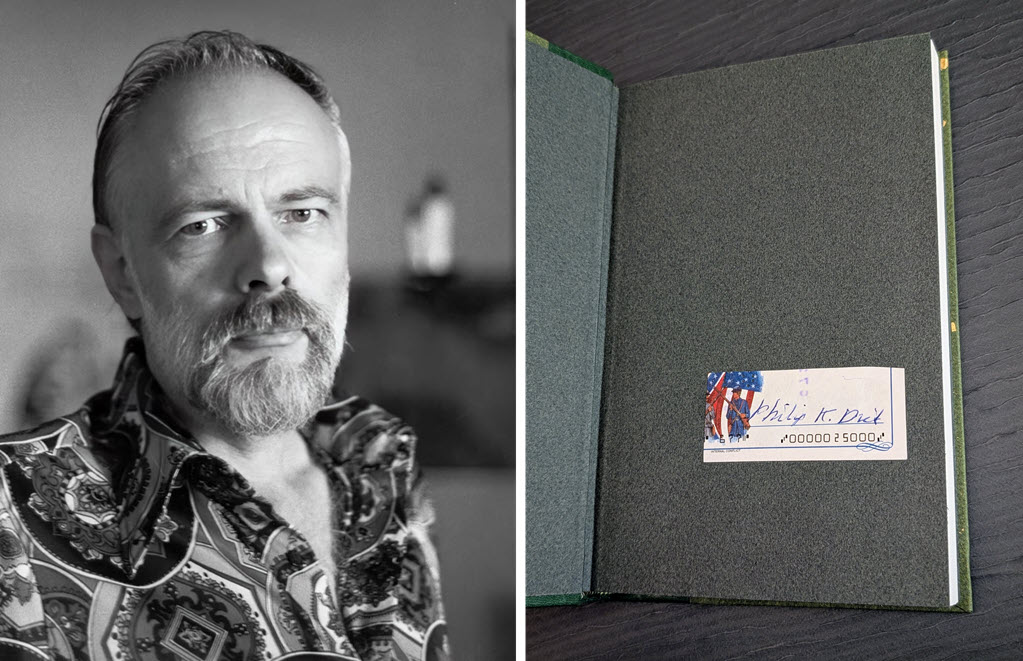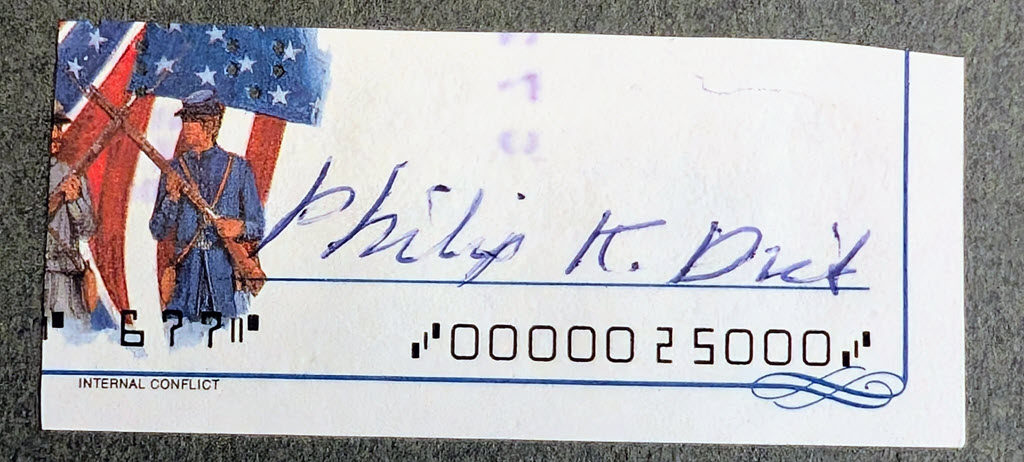
I have a limited edition of Philip K Dick’s novel In Milton Lumky Territory with the legendary author’s signature on the first page. Only 50 copies were signed and bound with the signature and the special quarter leather spine.
There’s a fun story about the signature.
Philip Dick was prolific, pounding out stories and novels during the 1950s and 1960s when science fiction writers were frequently paid a penny a word. During his career he wrote 36 science fiction novels and more than a hundred short stories. Many of the novels were only released during his lifetime in cheap paperback editions. Although PKD was highly regarded in the SF field, he was never a best-selling author, never made much money, seldom appeared at public events.
None of his SF novels were released as limited editions during his lifetime. Authors like Ray Bradbury and Stephen King achieved celebrity early and signed hundreds of thousands of books, including many signed limited editions. Philip Dick occasionally signed his books but not many, not often. Signed PKD books are hard to find and usually expensive.
It’s thrilling to have a Philip Dick signature for my collection. I spent years tracking it down.
But there’s a twist.
Blade Runner was the movie that first brought PKD to a global audience. His books and stories became fertile ground for movie and TV adaptations, so Blade Runner was followed by movies like Total Recall, Minority Report, and A Scanner Darkly, plus The Man In The High Castle miniseries and many more.
Philip Dick died in 1982, just before the Blade Runner movie was released that would make him famous.
After Blade Runner appeared, publishers scooped up his previously unpublished works to take advantage of his fame. In Milton Lumky Territory is one of several non-science fiction novels published after his death.
In Milton Lumky Territory, the signed book in my collection, was published in 1985, three years after Dick passed away.
“How can this be?” I hear you say. “He couldn’t have signed it, what with being dead and all.”
In the mid-1980s, PKD’s estate was signing deals left and right for movies and re-releases of old books. Dick’s literary executor, David Hartwell, owned a small private press, Dragon Press, and took on publishing Milton Lumky in both a regular and a signed limited edition.
A few thousand people kept up on PKD’s legacy thru a newsletter circulated by the Philip K Dick Society every few months. The announcement of the signed limited edition was sent to the PKD Society mailing list. By mail! With a stamp on the envelope! The 50 copies sold out right away, even at the then-outrageous price of $125. The announcement just said “each one will have a tipped in signature of PKD.”
All they needed was the signatures but PKD was still dead.
Someone had the idea to clip his signature from his canceled checks and glue them onto the front page. Voila! Signed books.
With that in mind, take a closer look at the signature.
Memories of canceled checks

This is a hidden age verification test.
If you are over fifty, you recognize that scrap of paper as the corner of a personal check.
If you are under fifty – in other words, you’re a youngster, at least to me, dammit – you have no idea what “canceled checks” are.
We wrote checks all the time. Paper checks. With pens. With our signature in the lower right corner. We would write them at the grocery store, mail them to pay our bills, go into the bank branch to deposit the ones we received.
It’s 1980, say. I write a check to my friend to pay for school supplies (wink wink) and the friend deposits the check at her bank.
Her bank would sort the deposited checks and endorse them to indicate they had been processed. The check – the physical piece of paper – would then start a long journey back to my bank. In our imagination armored cars and Brinks trucks carry bags of cash and diamonds, right? In the mundane real world of the 1980s, frequently they were carrying checks moving through the clearing house system.
My bank would deduct the money from my account and mark the check “PAID”. At the end of the month, the bank gathered up my original, canceled checks and mailed them back to me with a paper statement.
Think about that for a second. Our banks sent us a thick bundle by mail of every check we had written that month.
I did what everyone else did. I put those canceled checks in a shoebox and kept them forever. Just in case.
That’s why the estate of Philip Dick had his signature on hundreds of canceled checks, probably in a shoebox.
To finish the historical digression: banks were relieved from returning physical checks in 2004. It tailed off, some banks continued for a while, but by the end of the 2000s the era of paper canceled checks was over.
Signatures from dead authors
So the PKD estate and the publisher clipped out signatures from canceled checks and glued them into those 50 copies of In Milton Lumky Territory. They did the same thing three more times in the next few years. (Very limited editions of Mary And The Giant, Collected Stories, and Collected Letters.)
Ten years later, a book designer showed one of the PKD books with a canceled check to Stephen King and persuaded him to glue checks into a limited edition of The Regulators as a way to include signatures of his alter ego Richard Bachman, because King had previously declared that Bachman had died from “cancer of the pseudonym.” I told that story here.
I’m not aware of any other times that an author’s canceled checks have been used as a stand-in for a signature.
There are other creative ways to get around that problem.
I’ve got a Ray Bradbury book, Phoenix 451, published by Gauntlet Press in 2022. The publisher had done several projects with Bradbury during his lifetime and had unused signature pages from those products in its warehouse. That’s why the signature page in my copy of Phoenix 451 says “The October Country,” which Gauntlet had published 25 years earlier.
Some books have “facsimile” signatures, which means the author’s signature is printed on the page – just printed there, not even the pretense that a real hand had held a real pen. Sometimes the publishers take the time to say the author’s estate “approved” the signature, which still makes it just a printed picture. Centipede Press released a beautiful oversized limited edition of Dune with a “family approved” facsimile signature from Frank Herbert. That seems pretty meaningless to me but, umm, I’m the guy raving about a canceled check glued inside a book, what do I know.
Suntup Press and others handle it by arranging for family members or other interesting people to sign their limited editions. That’s why I have Slaughterhouse Five signed by Kurt’s daughter Edith Vonnegut, The Godfather signed by Francis Ford Coppola, and 1984 signed by Richard Blair, Orwell’s adopted son.
If you haven’t read any Philip Dick novels, you’re missing a treat, but don’t get In Milton Lumky Territory – a little earnest, not very memorable. Try one of his SF novels like Ubik, or The Three Stigmata of Palmer Eldritch, or The Man in the High Castle, or Do Androids Dream of Electric Sheep, or Time Out Of Joint, or A Scanner Darkly. You’ll emerge from a PKD novel shaking your head and saying, huh, that was a lot weirder than I expected. You’ll do that after each and every one. He was a singular talent.


A couple of years back, I picked up an Edgar Rice Burroughs cancelled cheque (check) on eBay, to put in my copy of Tarzan.
Terrific explanation, would never have thought something like this was done. I certainly approve of the idea, his signature is a treasure no matter where it came from.